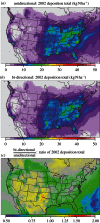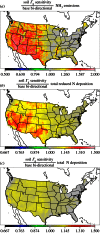Sensitivity of continental United States atmospheric budgets of oxidized and reduced nitrogen to dry deposition parametrizations
- PMID: 23713122
- PMCID: PMC3682744
- DOI: 10.1098/rstb.2013.0124
Sensitivity of continental United States atmospheric budgets of oxidized and reduced nitrogen to dry deposition parametrizations
Abstract
Reactive nitrogen (Nr) is removed by surface fluxes (air-surface exchange) and wet deposition. The chemistry and physics of the atmosphere result in a complicated system in which competing chemical sources and sinks exist and impact that removal. Therefore, uncertainties are best examined with complete regional chemical transport models that simulate these feedbacks. We analysed several uncertainties in regional air quality model resistance analogue representations of air-surface exchange for unidirectional and bi-directional fluxes and their effect on the continental Nr budget. Model sensitivity tests of key parameters in dry deposition formulations showed that uncertainty estimates of continental total nitrogen deposition are surprisingly small, 5 per cent or less, owing to feedbacks in the chemistry and rebalancing among removal pathways. The largest uncertainties (5%) occur with the change from a unidirectional to a bi-directional NH3 formulation followed by uncertainties in bi-directional compensation points (1-4%) and unidirectional aerodynamic resistance (2%). Uncertainties have a greater effect at the local scale. Between unidirectional and bi-directional formulations, single grid cell changes can be up to 50 per cent, whereas 84 per cent of the cells have changes less than 30 per cent. For uncertainties within either formulation, single grid cell change can be up to 20 per cent, but for 90 per cent of the cells changes are less than 10 per cent.
Keywords: atmospheric deposition; dry deposition uncertainty; nitrogen budget.
Figures



References
-
- Galloway JN, Townsend AR, Erisman JW, Bekunda M, Cai Z, Freney JR, Martinelli LA, Seitzinger SP, Sutton MA. 2008. Transformation of the nitrogen cycle: recent trends, questions, and potential solutions. Science 320, 889–89210.1126/science.1136674 (doi:10.1126/science.1136674) - DOI - DOI - PubMed
-
- Liu S, Lu L, Mao D, Jia L. 2007. Evaluating parameterizations of aerodynamic resistance to heat transfer using field measurements. Hydrol. Earth Syst. Sci. 11, 769–78310.5194/hess-11-769-2007 (doi:10.5194/hess-11-769-2007) - DOI - DOI
-
- Canfield DE, Glazer AN, Falkowski PG. 2010. The evolution and future of Earth's nitrogen cycle. Science 330, 192–19610.1126/science.1186120 (doi:10.1126/science.1186120) - DOI - DOI - PubMed
-
- Compton JE, Harrison JA, Dennis RL, Greaver TL, Hill BH, Jordan SJ, Walker H, Campbell HV. 2011. Ecosystem services altered by human changes in the nitrogen cycle: a new perspective for US decision making. Ecol. Lett. 14, 804–81510.1111/j.1461-0248.2011.01631.x (doi:10.1111/j.1461-0248.2011.01631.x) - DOI - DOI - PubMed
-
- Vitousek PM, Aber JD, Howarth RW, Likens GE, Matson PA, Schindler DW, Schlesinger WH, Tilman DG. 1997. Human alteration of the global nitrogen cycle: Sources and consequences. Ecol. Appl. 7, 737–75010.1890/1051-0761(1997)007[0737:haotgn]2.0.co;2 (doi:10.1890/1051-0761(1997)007[0737:haotgn]2.0.co;2) - DOI - DOI
Publication types
MeSH terms
Substances
LinkOut - more resources
Full Text Sources
Other Literature Sources
Molecular Biology Databases

